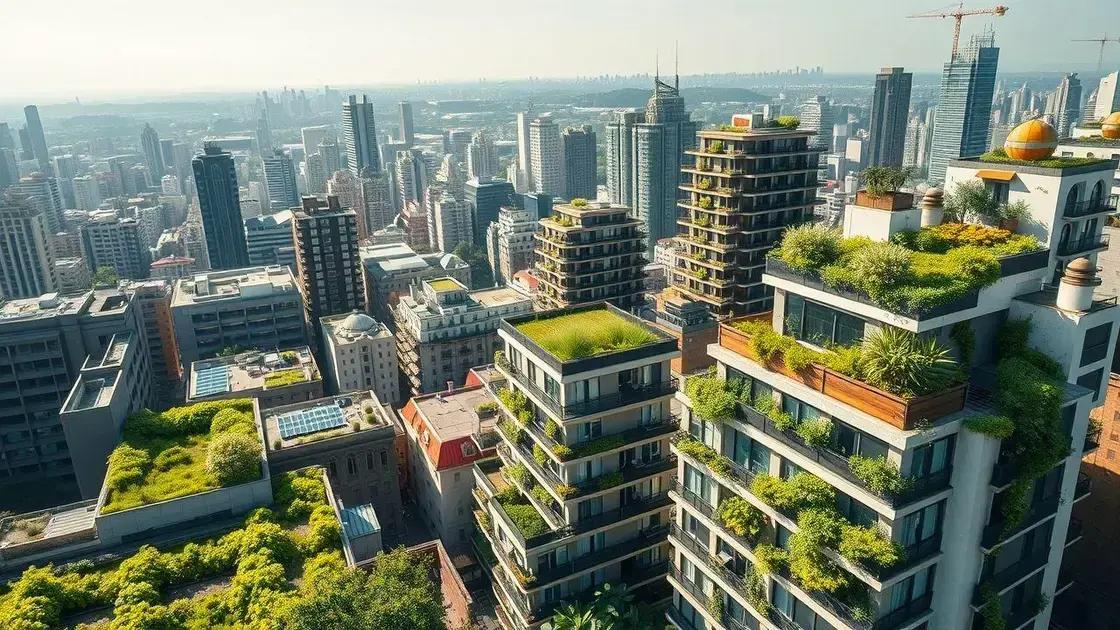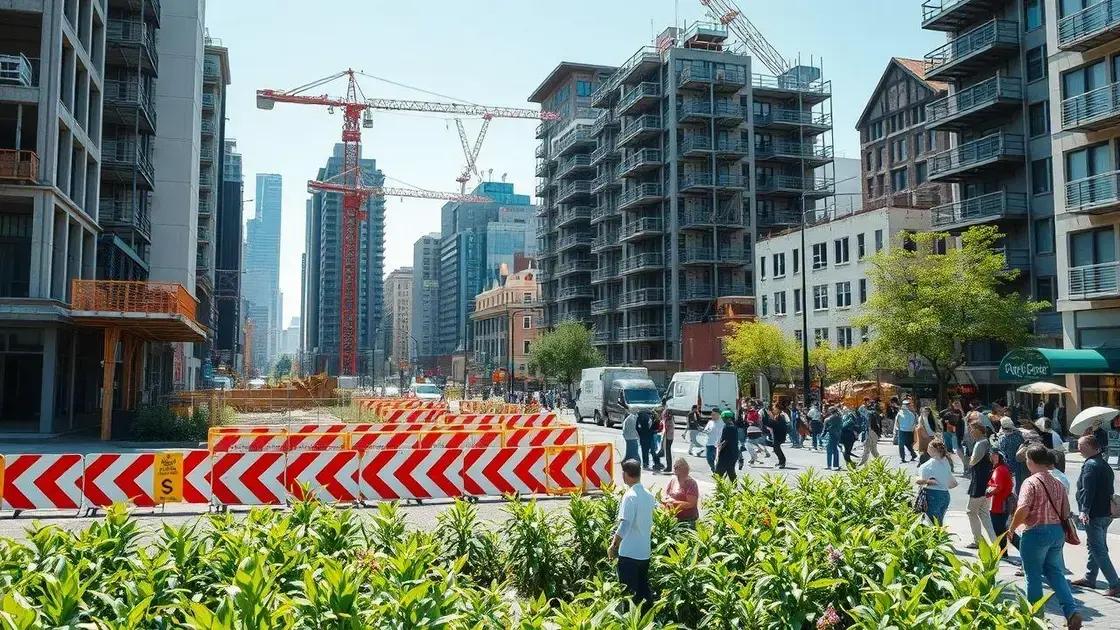Green infrastructure headlines trends driving urban transformation

Green infrastructure involves utilizing natural processes to improve urban environments, offering benefits like enhanced air quality, economic savings, and improved mental health through accessible green spaces.
Green infrastructure headlines trends are pushing cities to rethink their approach to urban planning. Have you ever wondered how sustainable practices can enhance our urban environments? Let’s dive into this evolving topic.
Understanding green infrastructure
Understanding green infrastructure is essential in today’s urban landscape. This approach uses natural systems to manage water, improve air quality, and enhance the livability of cities. Green infrastructure represents a shift in how we design and think about our urban spaces.
What is Green Infrastructure?
Green infrastructure incorporates natural elements to support environmental health. Unlike traditional infrastructure, which often prioritizes concrete and steel, this method uses plants, trees, and soil to work with nature rather than against it. This can include parks, green roofs, and rain gardens designed to absorb rainfall, reduce flooding, and purify air.
Key Benefits
- Enhances urban biodiversity by providing habitats for wildlife.
- Reduces the urban heat island effect through natural shading.
- Improves stormwater management, decreasing runoff and flooding.
- Increases property values as neighborhoods become greener and more attractive.
Communities that adopt green infrastructure not only enhance their ecological resilience, but also promote community well-being. Residents often feel more connected to nature, fostering mental health and a sense of belonging. As cities grow, integrating these natural elements becomes critical for sustainable development.
Implementing Green Infrastructure
Successful implementation requires collaboration across various sectors. City planners, architects, and community members must work together to develop strategies that fit local needs. For instance, incorporating green roofs in new buildings can help mitigate urban flooding while providing green spaces for residents.
Challenges to Consider
- Funding and resource allocation can be a barrier to projects.
- Cultural acceptance may vary with community values.
- Maintenance of green infrastructure is crucial for long-term success.
Overall, understanding green infrastructure allows us to envision a future where urban areas harmonize with nature. By collaborating, we can create sustainable, livable environments that benefit all. As we continue to explore and implement these strategies, the potential for positive change becomes clear.
Recent trends in urban green projects

Recent trends in urban green projects highlight a growing recognition of the importance of nature in city planning. Cities worldwide are embracing innovative solutions to improve sustainability and enhance the quality of life for residents. These trends reflect a shift toward integrating green spaces into urban environments.
Rise of Vertical Gardens
One major trend is the rise of vertical gardens, or living walls. These structures not only beautify buildings but also improve air quality. Vertical gardens help reduce urban heat and provide insulation, which can lead to lower energy costs. They can be found on both residential and commercial buildings, transforming bland facades into lush, green spaces.
Community Involvement in Green Spaces
Another important trend is increased community involvement in the creation and maintenance of green spaces. Local organizations are hosting workshops to encourage residents to plant native species and create community gardens. This engagement fosters a sense of ownership and responsibility, leading to more vibrant neighborhoods. Additionally, community-driven parks often reflect the unique character of their areas.
Green Roofs Gaining Popularity
Green roofs are increasingly common in urban settings. These living roofs provide various environmental benefits, such as stormwater management and biodiversity enhancement. By reducing runoff and improving drainage, they help cities cope with heavy rains. Furthermore, they offer recreational spaces for residents and wildlife alike.
- Green roofs lower indoor temperatures, resulting in energy savings.
- They offer habitats for birds and pollinators.
- Green roofs improve city aesthetics, making them appealing to residents and tourists.
Trends also indicate a shift toward designing urban parks for all ages and abilities. Playgrounds for children and fitness areas for adults are being incorporated into park designs, promoting wellness and community interaction. These spaces are essential for mental health, especially in high-density areas where open space is limited.
Overall, these trends in urban green projects showcase a commitment to creating healthier, more sustainable cities. As urbanization continues to grow, integrating nature into our urban landscapes is crucial for future generations.
Benefits of implementing green infrastructure
Implementing green infrastructure brings numerous benefits that go beyond aesthetics. These strategies not only enhance the environment but also improve the quality of life for urban residents. From reducing pollution to creating recreational spaces, the advantages are significant.
Environmental Benefits
One major benefit of green infrastructure is its positive impact on the environment. By using natural systems, cities can manage stormwater more effectively. This reduces flooding and prevents pollution from entering water bodies. Green spaces also help improve air quality, as plants absorb carbon dioxide and produce oxygen, creating cleaner air for residents.
Economic Advantages
Investing in green infrastructure can lead to economic savings over time. For instance, green roofs can lower energy costs by providing insulation, reducing the need for heating and cooling. Additionally, enhancing public parks and green spaces increases property values in surrounding areas. This can attract new residents and businesses, stimulating local economies.
- Reduced operational costs for stormwater management.
- Increased tourism due to attractive green spaces.
- Job creation in landscaping and environmental sectors.
Moreover, green infrastructure fosters community well-being by creating spaces for social interactions. Parks and green areas encourage outdoor activities, strengthening community ties. They serve as venues for events, markets, and recreational opportunities, all of which enhance community spirit.
Health Benefits
The health benefits of green infrastructure are profound. Access to green spaces has been linked to improved mental health and reduced stress levels. People are more likely to engage in physical activities when parks and recreational areas are available. These spaces provide safe places for exercise, play, and relaxation, contributing to overall well-being.
In summary, the benefits of implementing green infrastructure are clear. From environmental improvements to economic and health advantages, incorporating nature into urban environments offers a holistic approach to community development. As cities strive for sustainability, these practices become essential in shaping livable and resilient urban spaces.
Challenges in adopting green solutions

Adopting green solutions in urban planning presents several challenges that must be navigated effectively. Many cities desire to implement these sustainable practices but face obstacles that can hinder progress. Understanding these challenges is crucial for successful integration of eco-friendly initiatives.
Funding and Resources
One significant challenge is securing adequate funding. Many green infrastructure projects require substantial upfront investments. City budgets may be limited, making it difficult to allocate funds for these initiatives. Additionally, finding grants, partnerships, or sponsorships can be time-consuming and competitive.
Community Awareness and Engagement
Another challenge is raising community awareness about the benefits of green solutions. Residents may be unsure about the importance of investing in these technologies. Building strong community support takes time, education, and effective communication. Engaging citizens in the planning process ensures that projects meet their needs and gain their backing.
- Understanding local preferences is essential for project success.
- Public events and workshops can promote awareness.
- Involving stakeholders enhances transparency and trust.
Regulatory hurdles also pose significant challenges. Navigating complex zoning laws and building codes can delay project approvals. Each city has its unique regulations, and understanding these can be overwhelming for planners and advocates of green solutions. Coordinating with various government agencies adds to the complexity.
Maintenance and Sustainability
Once projects are implemented, ongoing maintenance is essential for their success. Green infrastructure requires regular upkeep to remain effective. Without proper maintenance, the benefits can diminish over time. Cities need to allocate resources for these tasks to ensure that green spaces and systems thrive.
Overall, while the challenges in adopting green solutions are significant, they are not insurmountable. With proper planning, community engagement, and financial strategies, cities can successfully integrate sustainable practices into their urban landscapes. This commitment leads to healthier environments and improved quality of life for residents.
green infrastructure in urban areas is not without its challenges, but the benefits make the effort worthwhile. By addressing funding issues, engaging communities, and navigating regulations, cities can create healthier environments. The positive impact of these solutions on the economy and public health cannot be ignored. Moving forward, it is essential for stakeholders to work together to overcome obstacles and ensure a sustainable future for urban living.
FAQ – Frequently Asked Questions about Green Infrastructure
What is green infrastructure?
Green infrastructure refers to systems that utilize natural processes to manage stormwater, improve air quality, and enhance urban environments.
What are the main benefits of implementing green solutions?
Implementing green solutions provides environmental benefits like improved air quality, economic savings through reduced energy costs, and enhanced community health.
What challenges do cities face in adopting green infrastructure?
Cities often struggle with funding, regulatory hurdles, and the need for community engagement when adopting green infrastructure projects.
How do green spaces contribute to mental health?
Access to green spaces has been linked to reduced stress and improved mental well-being, encouraging outdoor activities and social interactions.





